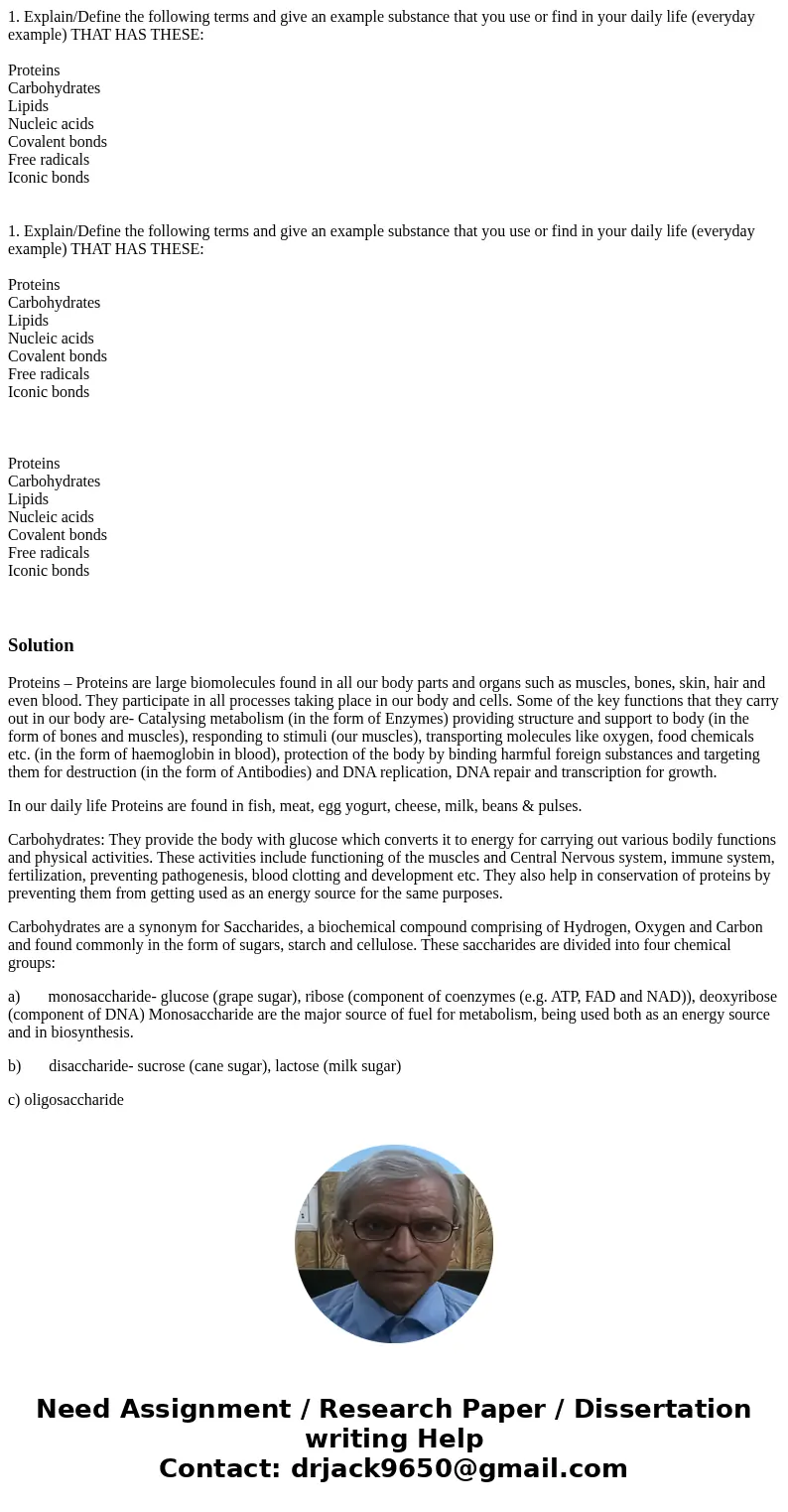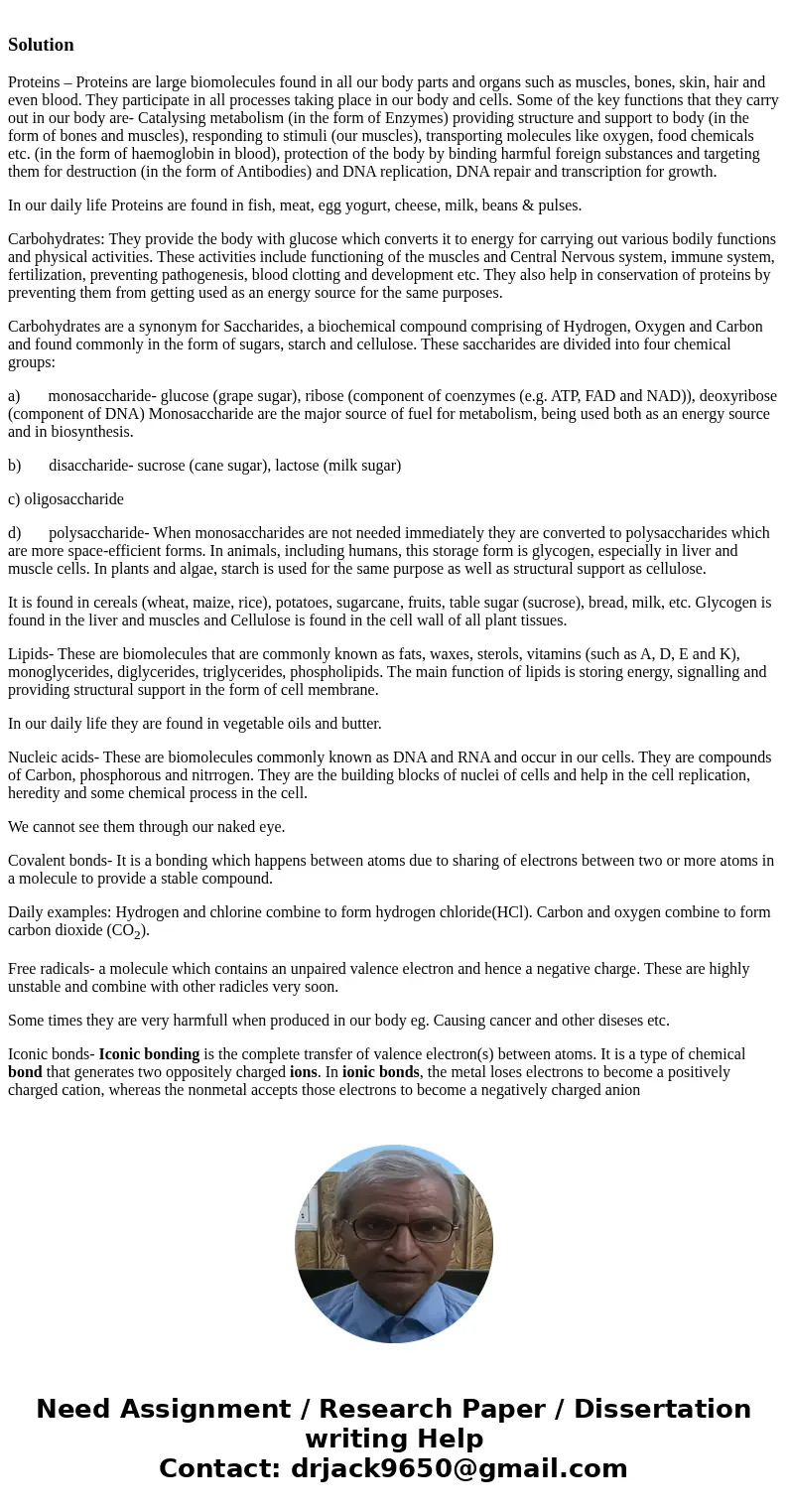1 ExplainDefine the following terms and give an example subs
Solution
Proteins – Proteins are large biomolecules found in all our body parts and organs such as muscles, bones, skin, hair and even blood. They participate in all processes taking place in our body and cells. Some of the key functions that they carry out in our body are- Catalysing metabolism (in the form of Enzymes) providing structure and support to body (in the form of bones and muscles), responding to stimuli (our muscles), transporting molecules like oxygen, food chemicals etc. (in the form of haemoglobin in blood), protection of the body by binding harmful foreign substances and targeting them for destruction (in the form of Antibodies) and DNA replication, DNA repair and transcription for growth.
In our daily life Proteins are found in fish, meat, egg yogurt, cheese, milk, beans & pulses.
Carbohydrates: They provide the body with glucose which converts it to energy for carrying out various bodily functions and physical activities. These activities include functioning of the muscles and Central Nervous system, immune system, fertilization, preventing pathogenesis, blood clotting and development etc. They also help in conservation of proteins by preventing them from getting used as an energy source for the same purposes.
Carbohydrates are a synonym for Saccharides, a biochemical compound comprising of Hydrogen, Oxygen and Carbon and found commonly in the form of sugars, starch and cellulose. These saccharides are divided into four chemical groups:
a) monosaccharide- glucose (grape sugar), ribose (component of coenzymes (e.g. ATP, FAD and NAD)), deoxyribose (component of DNA) Monosaccharide are the major source of fuel for metabolism, being used both as an energy source and in biosynthesis.
b) disaccharide- sucrose (cane sugar), lactose (milk sugar)
c) oligosaccharide
d) polysaccharide- When monosaccharides are not needed immediately they are converted to polysaccharides which are more space-efficient forms. In animals, including humans, this storage form is glycogen, especially in liver and muscle cells. In plants and algae, starch is used for the same purpose as well as structural support as cellulose.
It is found in cereals (wheat, maize, rice), potatoes, sugarcane, fruits, table sugar (sucrose), bread, milk, etc. Glycogen is found in the liver and muscles and Cellulose is found in the cell wall of all plant tissues.
Lipids- These are biomolecules that are commonly known as fats, waxes, sterols, vitamins (such as A, D, E and K), monoglycerides, diglycerides, triglycerides, phospholipids. The main function of lipids is storing energy, signalling and providing structural support in the form of cell membrane.
In our daily life they are found in vegetable oils and butter.
Nucleic acids- These are biomolecules commonly known as DNA and RNA and occur in our cells. They are compounds of Carbon, phosphorous and nitrrogen. They are the building blocks of nuclei of cells and help in the cell replication, heredity and some chemical process in the cell.
We cannot see them through our naked eye.
Covalent bonds- It is a bonding which happens between atoms due to sharing of electrons between two or more atoms in a molecule to provide a stable compound.
Daily examples: Hydrogen and chlorine combine to form hydrogen chloride(HCl). Carbon and oxygen combine to form carbon dioxide (CO2).
Free radicals- a molecule which contains an unpaired valence electron and hence a negative charge. These are highly unstable and combine with other radicles very soon.
Some times they are very harmfull when produced in our body eg. Causing cancer and other diseses etc.
Iconic bonds- Iconic bonding is the complete transfer of valence electron(s) between atoms. It is a type of chemical bond that generates two oppositely charged ions. In ionic bonds, the metal loses electrons to become a positively charged cation, whereas the nonmetal accepts those electrons to become a negatively charged anion


 Homework Sourse
Homework Sourse